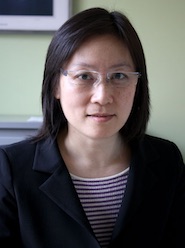| Center |
|
| Award Year | 2024 |
| Pilot Study | The in vivo function and dysfunction of human α-cells derived from stem cells or in pseudo T1D-islets |
| Awardee |
Xiaojuan Chen MD PhD
|
| Abstract |
The beneficial paracrine signaling of α-cells in enhancing glucose-stimulated insulin secretion from β-cells is an important consideration in the field of stem cell (SC)-derived islet replacement therapy for diabetes. While the SC derived β-cells have been thoroughly characterized in vitro and in vivo, limited information is available regarding the generation and the glucagon-secretion characteristics of SC derived αcells. The regulated glucagon secretion by the SC-α-cells remained to be further studied. We propose to characterize the phenotype of human SC-derived α-cells in vivo after transplant, a step known to promote maturation of the SC-derived islet cells, and comparing it to that of primary human islet α-cells. In addition, although pancreatic α-cells persist in T1D islets, they are often incapable of mounting an appropriate glucagon response in the event of hypoglycemia induced by insulin injection. Recent studies also suggest that α-cell dysfunction contributes to chronic hyperglycemia in patients with T1D due to hyperglucagonemia. For a better glycemic control of patients with diabetes, especially those with reoccurring hypoglycemia, it is important to understand the potential mechanisms involved in the α-cell pathophysiology in diabetes. We have used combined approaches to study glucagon secretion by human α-cells in a pseudo T1D islet model which contains all islet endocrine cells except β-cells after transplant in immune deficient NSG mice without endogenous glucagon production (GCG-KO). Preliminary results have demonstrated successful subcutaneous engraftment of the pseudo-T1D islets in the NSG-GCG-KO mice. The graft glucagon secretion was dose-dependent and increased in response to insulin-induced hypoglycemia. Such graft α-cell function was compromised after a chronic (3 weeks) hyperglycemia exposure, leading to a situation of hyperglucagonemia in the presence of hyperglycemia and a lack of increased glucagon secretion in response to insulin-induced hypoglycemia. We propose to utilize the NSG GCG-KO mice to 1) characterize the function and gene expression of human pluripotent SC (hPSC)-derived α-cells after transplant and compare it to that of primary islet α-cells transplanted; and 2) perform time course studies of gene/protein expression in α-cell grafts exposed to chronic hyperglycemia. These studies will facilitate the efforts in hPSC-islet-cell generation, establish a method for future studies of hPSC-α-cells in a personalized manner, and provide valuable information regarding the mechanisms involved in the hyperglycemia-induced islet α-cell dysfunction. |
